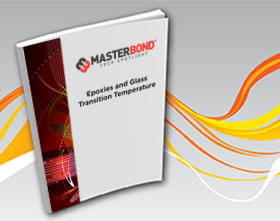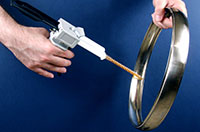|
|
| New White Paper: Epoxies and Glass Transition Temperature
|
Gain a better understanding about glass transition temperature (Tg) and why it is one of many factors to consider for bonding, sealing, coating and encapsulation applications. In this paper, we explore how temperature impacts the performance of polymers, why glass transition temperature is significant, and how it is measured.

|
|
|
|
Toughened Epoxy Resists Up To 500°F
|
This non-drip past epoxy has an attractive balance of superior shear and peel strength for high performance structural bonding Supreme 46HT-2ND2 is suitable for applications where a wide service temperature range of -100°F to +500°F is required. It produces durable, tough bonds which are remarkably resistant to thermal cycling as well as a wide variety of chemicals including water, many acids, bases, solvents, fuels and oils.
For more information, request a technical data sheet on Supreme 46HT-2ND2 |
|
|
|
Fast Setting Metal Bonding System |
EP65HT-1 offers the unique combination of ultra fast cures at room temperature and high thermal stability. This two component epoxy sets up in just 3-5 minutes at 75°F and can withstand temperatures up to 400°F. It has a remarkable glass transition temperature of about 125°C. It also meets NASA low outgassing requirements. Available for use in a convenient application gun, this compound features superior dimensional stability and tensile strength properties.
For more information, request a technical data sheet on EP65HT-1 |
|
|
|
No Mix Epoxy Has Excellent Heat Dissipation Properties |
Supreme 10ANHT offers both high shear and peel strengths along with exceptional thermal conductivity. This unique system provides superior resistance to impact, thermal shock, vibration and stress fatigue cracking while maintaining the moisture, creep, corrosion and thermal resistance typical of epoxy resin adhesives.
For more information, request a technical data sheet on Supreme 10ANHT |
|
|
|
Structural Adhesive Serviceable To 650°F
|
Master Bond EP17HT features outstanding physical strength properties, a superb electrical insulation profile and first rate chemical resistance. This one part system also has superior heat resistance with a glass transition temperature (Tg) of about 220-225°C. EP17HT bonds well to similar and dissimilar substrates such as metals, ceramics, glass, rubbers and most plastics. Resistance to acids, bases, salts, fuels, oils and many solvents is excellent. It has a very low exotherm and can cure in thicknesses greater than ½ inch.
For more information, request a technical data sheet on EP17HT |
|
|
|
Versatile, Optically Clear Two Part System
|
With a glass transition temperature exceeding 175°F, EP30-3LO combines superior chemical resistance along with passing NASA low outgasing testing requirements. It has an easy to use 100 to 30 mix ratio by weight, and while it requires heat curing, it offers a long open time of 6-10 hours. It bonds well to a wide variety of substrates including metals, glass, composites and many plastics and rubbers.
For more information, request a technical data sheet on EP30-3LO |
|
|
|
UV Curable System Has a Glass Transition Temperature >180°C |
UV25 offers exceptional thermal stability over the broad service temperature range of -60°F to +500°F. This one part, moderate viscosity UV curable system bonds well to glass, surface treated metals and plastics such as polycarbonates and acrylics, among others. Additionally, this material is optically clear with a refractive index of 1.55 at room temperature.
For more information, request a technical data sheet on UV25 |
|
|
|
Copyright  2014 by Master Bond Inc. All Rights Reserved. This content may not be reproduced in any way without the prior written permission of Master Bond Inc. 2014 by Master Bond Inc. All Rights Reserved. This content may not be reproduced in any way without the prior written permission of Master Bond Inc.
|
|
 View this email online
View this email online



 September 2014
September 2014






